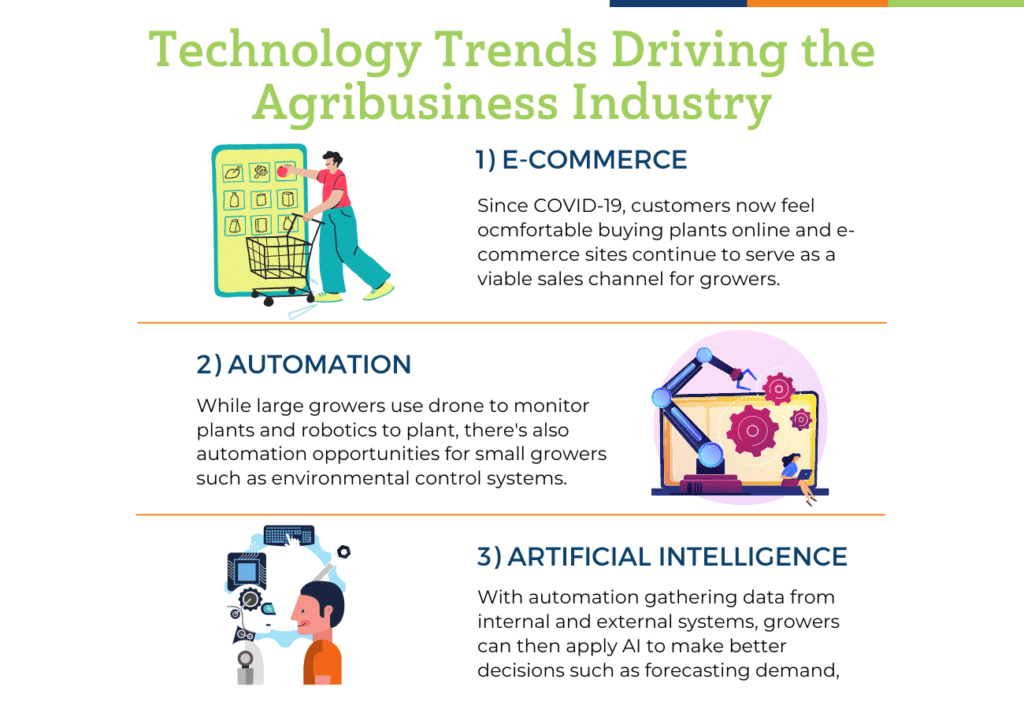3 Technology Trends Driving the Agribusiness Industry
Learn about three technology trends currently driving the agribusiness industry and how growers can take advantage of all the data these technologies produce.
Learn about three technology trends currently driving the agribusiness industry and how growers can take advantage of all the data these technologies produce.
As plant and flower growers look for ways to survive and thrive in their marketplaces, it’s critical to consider the ways technology can be leveraged—to operate more efficiently and to gain access to information that accelerates decision-making.
In this blog, we examine three technology trends currently driving the agribusiness industry and how growers can take advantage of all the data these technologies produce.
 Three Technology Trends Driving the Agribusiness Industry
Three Technology Trends Driving the Agribusiness IndustryThe trend of building e-commerce websites for retail sales emerged during Covid. Customers used to resist buying plants online, but with so many people staying home, many started to garden. Since no one wanted to go to garden stores, a lot of growers set up e-commerce sites where customers could place their orders just as they have for many years in other retail shopping sectors.
Since Covid, customers now feel comfortable buying plants online, and e-commerce sites continue to serve as a viable sales channel for growers. This includes selling directly from their own websites as well as drop-shipping orders that come in from sites managed by the big box stores as well as online plant and flower sellers.
While large growers use drones to monitor plants and robotics to pot plants, there are also automation opportunities for smaller growers. Environmental control systems can automate soil identification and shade management while also helping measure and manage soil moisture, air moisture, greenhouse temperatures, water quantities, climate changes, and light exposure. With the emergence of IoT (Internet of Things) in recent years, control systems can be easily managed, and data can be easily available.
And with mobile device access, growers can automate data entry. Instead of carrying a clipboard, the staff uses devices to enter updates on plant status and inventory counts. The data is automatically collected and saved so there’s no need to manually key in the data—it’s faster with fewer errors, and no pieces of paper left behind. With mobile data entry tracking orders that are fulfilled and shipped, growers can also immediately recognize and capture costs, such as fertilizer and pest control products applied to plant lots.
Artificial intelligence (AI) is a technology that has recently gained popularity in all walks of life. With automation gathering data from internal and external systems, growers can then apply AI to make better decisions, such as forecasting demand based on industry drivers (like a recession). They can also determine when to adjust predicted yield and plant readiness based on the projected weather—knowing when spring will start and when it will end.
Essentially, AI gives growers the ability “start a conversation with the data” using an intelligence engine that lets users define reports by asking questions. AI then finds the trends. For example, the technology can look at external factors to forecast consumer spending. Managers can also query a combination of environmental control data and ERP data to see why the water bill was particularly high. Perhaps the business planted XX% more plants than last year and therefore used more water.
Though AI is just making its debut in the industry, expect to see all kinds of creative applications of this technology in the future.
With e-commerce, automation, and AI systems collecting data and transacting sales, it’s critical for growers to integrate that activity with their ERP system. With data automatically stored in an ERP system tailored for the grower industry—such as SilverLeaf running on Microsoft Dynamics 365 Business Central—you can also avoid re-keying information and easily report on what’s going on in your business.
With SilverLeaf, you can build a historical record of plant lifecycles and customer transactions. Rather than sorting through isolated manual notes, you have centralized data to run reports against using a tool like Microsoft Power BI.
You can also leverage desktop and mobile devices to gain automatic access to the data produced by IoT sensors. This gives you the ability to analyze historical records, such as the amount of light, the amount of rain, or the average temperature during a growing season. It’s an ongoing record of what you did so can see which variables contributed to good or bad growing seasons.
Another vital area in which growers can leverage AI to analyze data produced by automated systems is sustainability strategies—including water conservation, waste management, energy usage reduction, and tapping into renewable energy sources. As your environmental control systems manage your resources, AI can help you understand how to reduce your use of water and energy.
For more information on how SilverLeaf running on Dynamics 365 Business Central can give your agribusiness access to vital information, contact Velosio today.
Talk to us about how Velosio can help you realize business value faster with end-to-end solutions and cloud services.